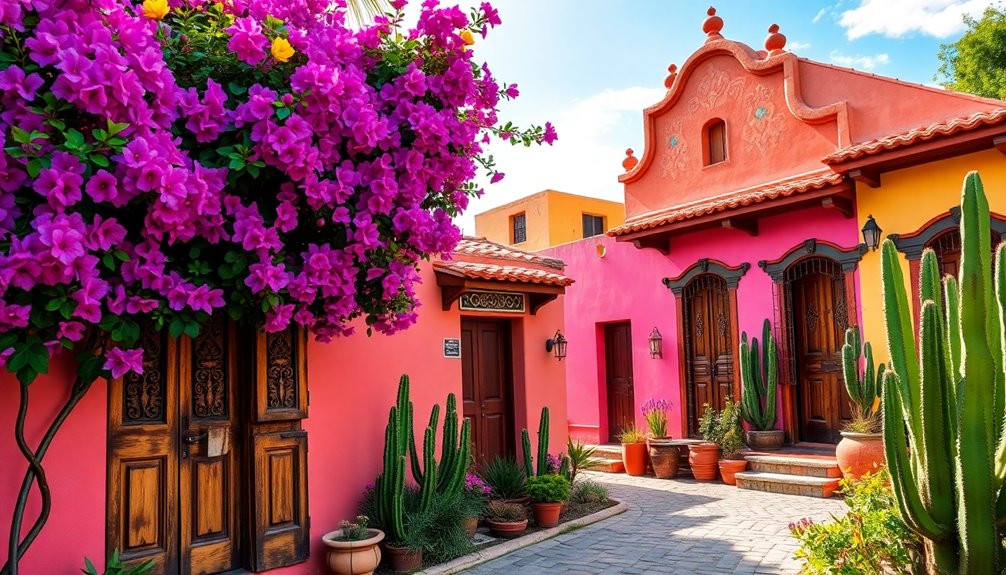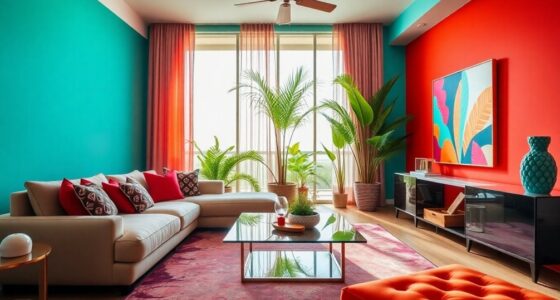Mexican houses are a vivid mix of colors and styles, showcasing a rich cultural history. You'll notice features like arched doorways and terracotta roofs, which blend indigenous and Spanish colonial influences. Homes often use local materials like adobe and stone, creating a unique connection to the environment. Each region displays its own style, from coastal homes designed for ventilation to northern dwellings built for sturdiness. Traditional haciendas boast beautiful courtyards, while modern luxury homes emphasize eco-friendly designs. This diversity reflects a proud architectural identity. Keep exploring to discover even more about the fascinating world of Mexican home styles.
Key Takeaways
- Mexican houses often feature vibrant colors, reflecting the rich cultural heritage and enhancing their visual appeal.
- Common design elements include arched doorways, terracotta roofs, and wrought iron details, showcasing traditional craftsmanship.
- Architectural styles vary regionally, with coastal homes designed for humidity and northern houses using sturdy materials for arid climates.
- Iconic styles like Spanish villas and haciendas highlight a blend of indigenous and colonial influences, emphasizing cultural identity.
- Modern luxury homes incorporate eco-friendly elements while maintaining traditional aesthetics, fostering a connection to cultural roots.
Characteristics of Mexican Architecture
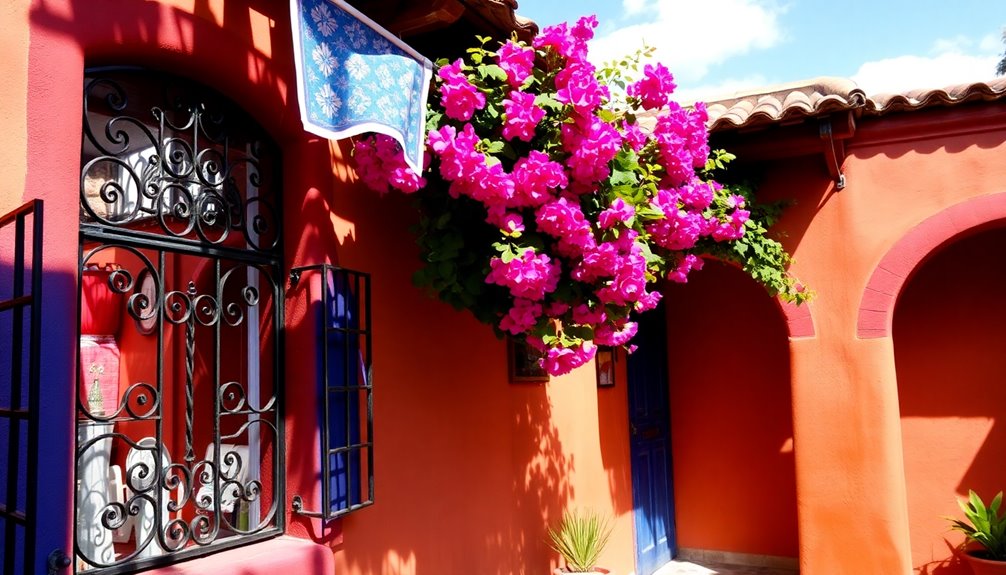
When you explore Mexican architecture, you'll notice its vibrant colors that reflect the region's rich cultural heritage. This style features distinctive design elements like arched doorways and windows, terracotta tile roofs, and intricate wrought iron and ceramic details.
Traditional materials such as adobe, stone, and wood are often incorporated, emphasizing a sustainable connection to the local environment.
As you investigate deeper, you'll find regional variations showcasing adaptations to climate; lighter structures grace coastal areas, while northern regions utilize more stone and adobe.
The fusion of indigenous building techniques with Spanish colonial influences creates a unique architectural identity, illustrating Mexico's rich history and culture. This vibrant blend makes Mexican architecture truly enchanting and diverse.
Historical Influences on Design
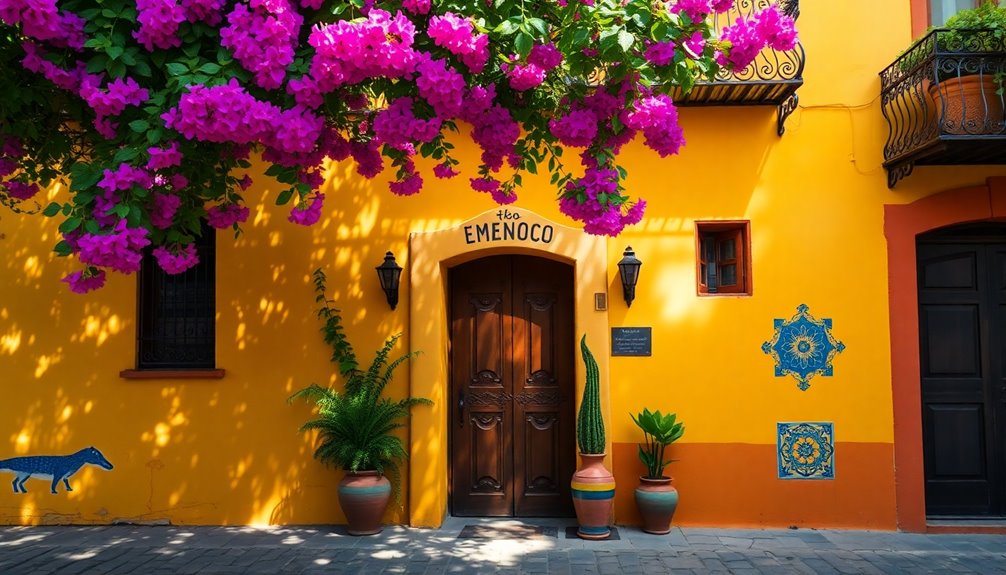
The evolution of Mexican architecture is a fascinating journey shaped by various historical influences that have left their mark on design. Here are three key influences that define its architectural style:
- Pre-Columbian Foundations: Indigenous structures established essential design principles, using materials like adobe.
- Spanish Colonial Impact: The introduction of baroque and neoclassical styles transformed aesthetics and structural elements in homes.
- Cultural Pride Post-Revolution: The Mexican Revolution spurred a revival of traditional styles, emphasizing national identity.
This blend of European and native influences creates a unique architectural identity in Mexico.
You'll notice vibrant colors, intricate details, and open spaces that reflect the country's rich heritage, showcasing how historical influences continue to shape modern designs today.
Regional Variations in Style
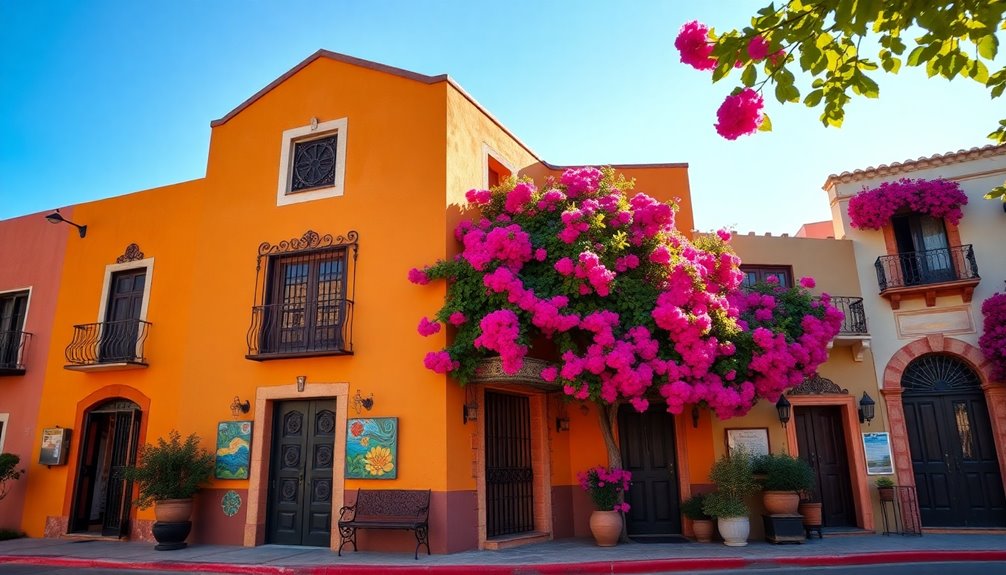
When you explore regional variations in Mexican home styles, you'll notice how coastal architecture adapts to humidity with lighter structures and open layouts.
In contrast, northern homes utilize sturdy stone and adobe materials to withstand the arid climate.
Each region reflects its unique environment, shaping the way you experience these beautiful spaces.
Coastal Architectural Adaptations
Coastal architectural adaptations in Mexico showcase a unique blend of functionality and aesthetics, designed to thrive in the region's humid and often stormy environment.
These contemporary Mexican homes emphasize:
- Lighter Structures: Elevated designs using concrete and wood combat humidity and flooding.
- Open-Air Living: Expansive windows and seamless indoor-outdoor spaces maximize ventilation and ocean views.
- Sustainable Features: Incorporating rainwater harvesting and passive solar design enhances energy efficiency.
Additionally, terracotta tile roofs not only add charm but also insulate against heat.
Many coastal homes reflect tropical influences, boasting spacious terraces and outdoor areas perfect for leisure by the beach.
This thoughtful design guarantees comfort and enjoyment in a beautiful coastal setting.
Northern Climate Influences
While exploring the diverse architectural styles in Mexico, you'll find that northern homes are distinctly influenced by the region's harsh climate.
To combat extreme temperature fluctuations, builders often use thick adobe homes and stone walls for insulation. You'll notice low-pitched roofs designed to shed rainwater efficiently during the rare storms. Wrought iron details and vibrant tile work add traditional charm while enhancing functionality.
Many homes feature courtyards that promote natural ventilation, perfect for outdoor living in hot weather. This unique architecture beautifully merges indigenous building techniques with Spanish colonial influences, resulting in resilient designs that reflect the needs of those living in the northern climate.
Each home tells a story of adaptation and harmony with its environment.
Sustainable Building Practices
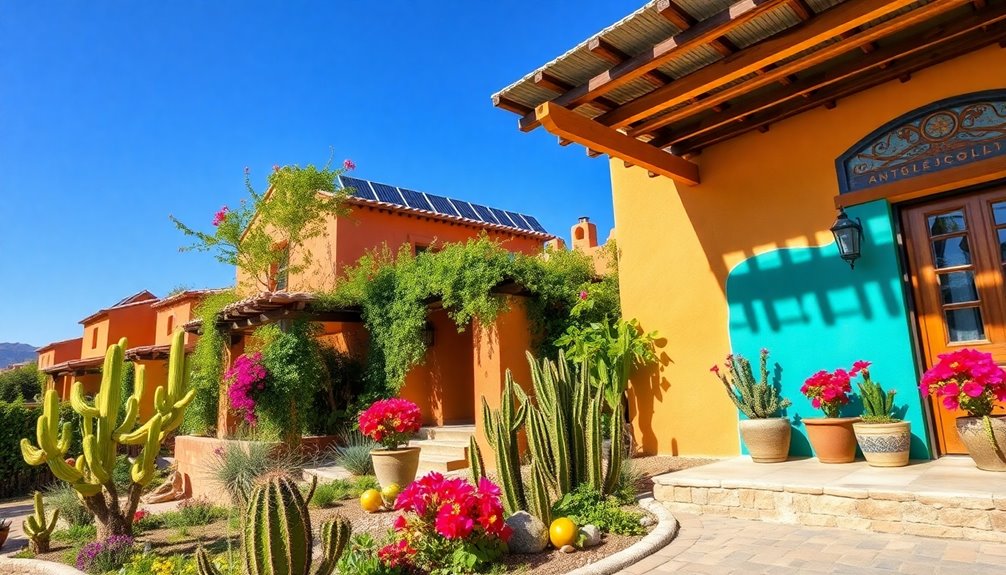
When building a home in Mexico, you can embrace sustainable practices by using local materials like adobe and stone. Incorporating passive solar design helps maximize natural light and cut down on energy costs. Plus, installing rainwater harvesting systems allows you to reuse water, making your home both eco-friendly and efficient. Utilizing renewable resources like wood for heating can further enhance the sustainability of your home.
Local Material Utilization
In many Mexican homes, the use of local materials like adobe, stone, and wood creates not just stunning aesthetics but also fosters sustainability.
By prioritizing local material utilization, these homes connect deeply with their natural surroundings. Here are a few benefits of this approach:
- Reduced Transportation Emissions: Sourcing materials locally minimizes the carbon footprint associated with transporting building supplies.
- Energy Efficiency: Techniques like adobe construction help regulate indoor temperatures, cutting down on energy consumption.
- Water Conservation: Modern designs often include rainwater harvesting systems, making the most of local resources and reducing waste.
Emphasizing local materials supports the local economy and enhances biodiversity, creating homes that truly reflect their environment. Additionally, this practice mirrors the historical context of sustainable practices in various cultures, including the ancient techniques used by early butter makers.
Passive Solar Design
Passive solar design is a cornerstone of sustainable building practices in Mexican homes, expertly harnessing the sun's energy to create comfortable living spaces.
You'll notice large south-facing windows that maximize natural light and warmth during winter while minimizing overheating in summer with strategically placed shade elements.
The use of thermal mass materials, like adobe and stone, enhances energy efficiency by absorbing heat during the day and releasing it at night.
Roof overhangs and pergolas provide essential shade, reducing glare and promoting natural ventilation to cool your indoor spaces.
Many contemporary homes also feature green roofs and terraces, offering insulation, promoting biodiversity, and contributing to urban cooling, making your home not just comfortable but also environmentally friendly.
Rainwater Harvesting Systems
Sustainable building practices in Mexican homes extend beyond passive solar design to include innovative rainwater harvesting systems.
These systems help reduce dependency on municipal water supplies while promoting sustainability. By integrating rainwater harvesting into your home, you can benefit in several ways:
- Cost Savings: Households can save up to 50% on water bills by using harvested rainwater for irrigation and non-potable needs.
- Water Independence: In some regions, these systems can provide up to 70% of a household's water needs during seasonal rains.
- Local Materials: You can incorporate gutters, downspouts, and storage tanks made from local materials, aligning with traditional design principles.
Implementing rainwater harvesting systems not only conserves water but also encourages responsible management practices.
Contemporary Architectural Trends

As contemporary Mexican architecture evolves, it embraces open floor plans that create a seamless connection between indoor and outdoor spaces, perfect for those who value a fluid lifestyle.
You'll often see modern homes featuring natural materials like stone, wood, and concrete, emphasizing durability while maintaining aesthetic appeal.
Expansive windows and glass walls are common in contemporary designs, flooding your home with natural light and offering breathtaking views of the surrounding landscape.
Additionally, the inclusion of eco-friendly elements such as solar panels and rainwater harvesting systems reflects a growing commitment to sustainability.
Handcrafted details and traditional design elements enrich contemporary architecture, preserving cultural identity while effortlessly blending with modern trends, making your living space unique and inviting.
Moreover, many contemporary homes draw inspiration from traditional Indonesian housing styles, showcasing how cultural heritage can influence modern design.
Iconic Home Styles
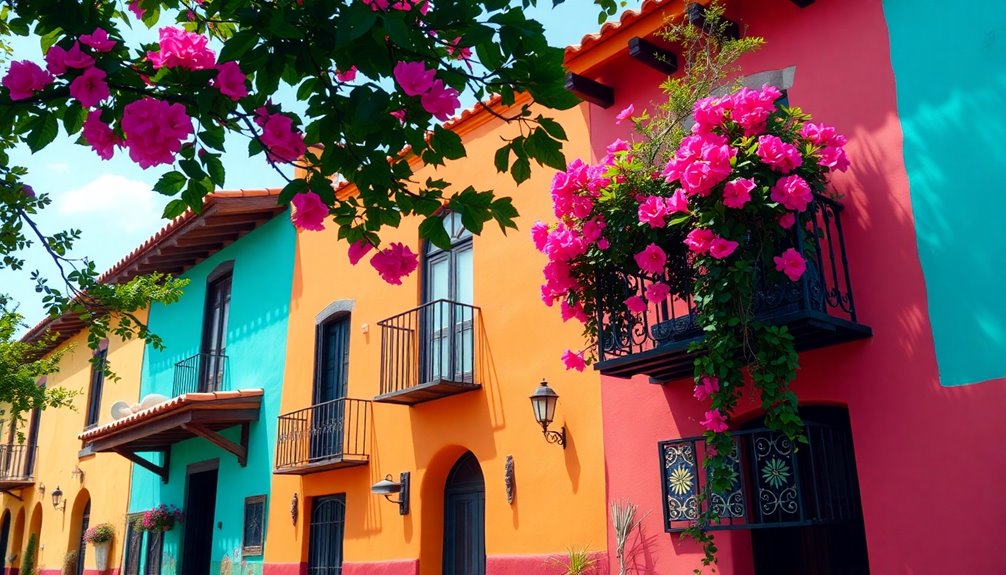
Contemporary architectural trends have paved the way for a deeper appreciation of iconic Mexican home styles that reflect the country's rich cultural heritage.
Each style offers unique characteristics that resonate with tradition and modernity. Here are three prominent examples:
- Spanish Villas: With bright red tile roofs and arched doorways, these homes blend elegance and craftsmanship.
- Haciendas: These sprawling residences feature cobblestone courtyards and high ceilings, designed for upper-class living.
- Adobe Homes: Modernized from ancient Aztec designs, they include mud-glazed walls and terracotta floors, merging history with contemporary aesthetics.
Traditional Mexican Haciendas
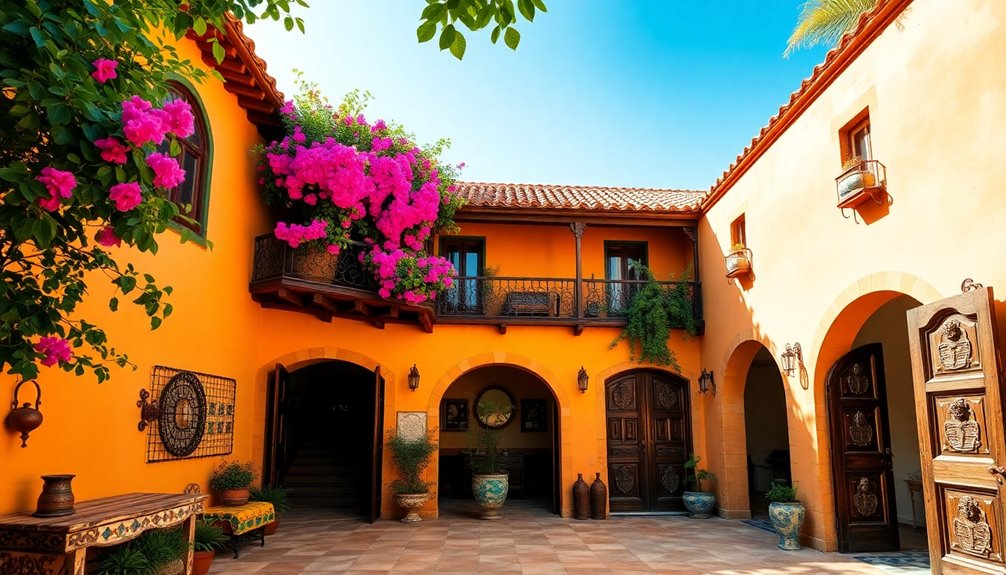
When you explore traditional Mexican haciendas, you'll discover stunning architectural features like terracotta roofs and vibrant Talavera tiles.
These homes not only reflect a rich cultural heritage but also adapt to modern uses, often becoming luxury hotels or historical sites.
Let's uncover how these elements come together to create a unique living experience.
Architectural Features Overview
Traditional Mexican haciendas embody a unique architectural style that reflects the region's rich agricultural history and vibrant culture.
Mexican homes often showcase distinct architectural features that make them stand out. Here are three key elements:
- Terracotta Tile Roofs: These durable roofs not only add vibrant color but also harmonize with the landscape.
- High Ceilings and Talavera Tiles: Inside, you'll find spacious areas adorned with hand-painted tiles, highlighting exquisite craftsmanship.
- Intricate Wooden Doors: Large doors with decorative ironwork serve as functional yet stunning focal points.
Additionally, the extensive cobblestone courtyards and shaded patios promote outdoor living, allowing you to enjoy the warm climate while connecting with nature and community.
Cultural Significance and Heritage
While exploring the rich tapestry of Mexican culture, you'll find that haciendas are more than just homes; they're living symbols of the country's agricultural heritage and social history.
Originating during the colonial era, these sprawling one-story residences served as self-sustaining estates, shaping Mexico's economic and social structure. Their thick stone walls and terracotta roofs reflect local building traditions, while intricate details like hand-painted Talavera tiles and wrought ironwork emphasize craftsmanship and cultural pride.
Haciendas promote outdoor living through shaded pergolas and cobblestone courtyards, fostering community interaction.
Today, many original haciendas in places like Playa del Carmen are preserved as historical sites or luxury hotels, showcasing their architectural significance and cultural heritage to visitors from around the world.
Modern Adaptations and Uses
As modern needs evolve, many traditional Mexican haciendas have been transformed into luxurious retreats and historical landmarks that blend the charm of the past with contemporary comforts.
These stunning Mexican houses embrace natural beauty while offering guests an unforgettable experience. Here are some popular adaptations:
- Luxury Hotels: Many haciendas now serve as upscale accommodations, featuring modern amenities without sacrificing their architectural integrity.
- Event Venues: With picturesque courtyards and shaded patios, haciendas are perfect for weddings and celebrations, showcasing Mexico's vibrant culture.
- Cultural Centers: Some haciendas have become educational sites, promoting the region's heritage through art and cooking classes.
These adaptations guarantee that the spirit of traditional haciendas continues to thrive in today's world, merging history with modernity.
Modern Luxury Homes
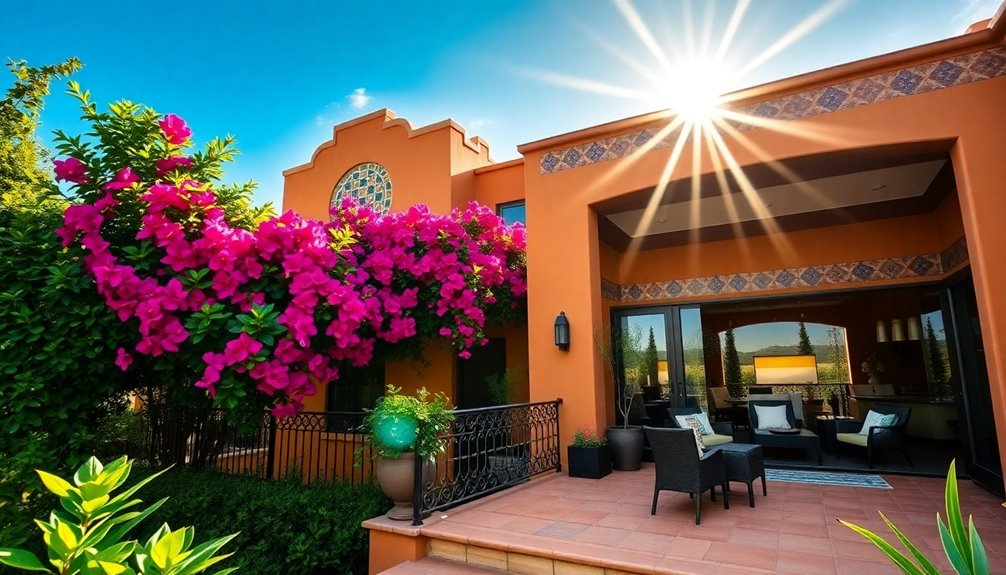
Modern luxury homes in Mexico redefine elegance, offering a harmonious blend of indoor and outdoor living.
You'll find expansive open floor plans that maximize natural light and showcase stunning views, creating an inviting atmosphere. These homes often use natural materials like stone, wood, and concrete, ensuring durability while reflecting local cultural identity through handcrafted details.
Many residences also incorporate eco-friendly elements, such as solar panels and rainwater harvesting systems, promoting sustainability in design.
Located in prime destinations like Playa del Carmen, these modern luxury homes provide breathtaking ocean views and access to world-class amenities.
With contemporary designs inspired by traditional Mexican architecture, they effortlessly combine vibrant colors and intricate details with the minimalist trends favored by younger generations.
Construction Practices in Mexico
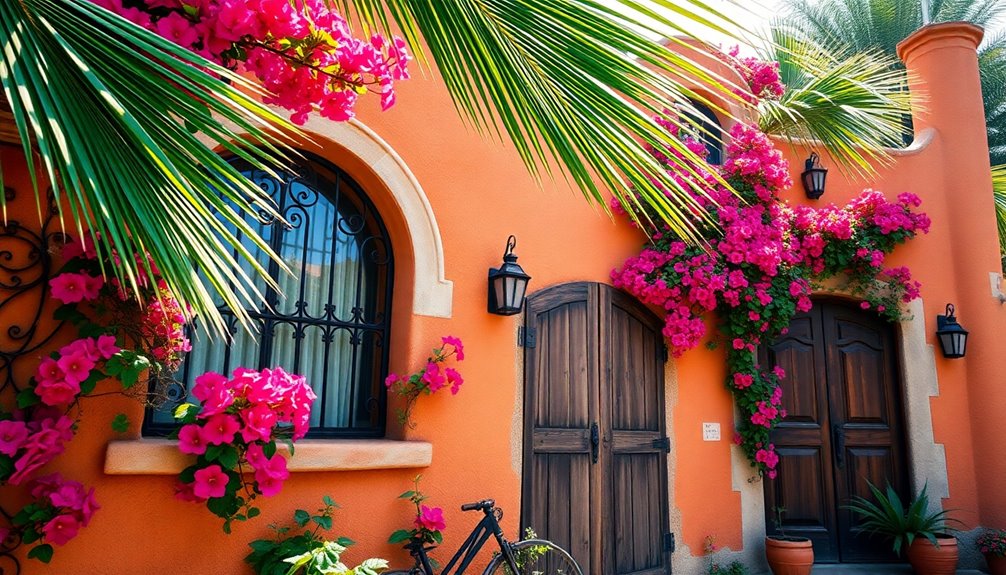
The stunning modern luxury homes in Mexico showcase how architectural styles evolve, but they also highlight traditional construction practices that remain essential to the country's identity.
You'll find that these practices draw heavily from the heritage of Mexico, emphasizing local materials and community involvement. Here are three key aspects to reflect upon:
- Materials: Adobe and stone are commonly used, reflecting sustainability and climate adaptation.
- Modern Techniques: Reinforced concrete frames are the norm for structural integrity, especially in earthquake-prone areas.
- Community Influence: Local design preferences guarantee homes resonate with cultural significance, showcasing a blend of indigenous and colonial influences.
These construction practices not only define the physical structures but also connect them to their cultural roots.
Design and Renovation Insights

When you think about renovating or designing a home in Mexico, blending traditional elements with contemporary features can create a unique and inviting space.
Incorporating Talavera tiles and wrought iron details preserves cultural heritage while modernizing your home. Emphasizing open floor plans and large windows allows for seamless shifts between indoor and outdoor living, enhancing your overall experience.
Sustainable renovation practices, like using local materials and rainwater harvesting systems, boost energy efficiency and reduce your environmental footprint.
Don't forget the vibrant exterior palettes—these colorful hues reflect local culture and make your home visually striking.
Finally, including courtyards in your design enhances natural light and ventilation, fostering a deep connection with nature, a key aspect of Mexican architectural tradition.
Frequently Asked Questions
What Does a Typical Mexican Home Look Like?
A typical Mexican home bursts with vibrant colors, often painted in shades of yellow, blue, or pink.
You'll notice arched doorways and windows, along with terracotta tile roofs that add character. Many homes feature central courtyards, allowing for natural light and ventilation.
Inside, you might find handcrafted details like Talavera tiles and artisan woodwork, showcasing the rich cultural artistry.
Traditional materials like adobe and stone connect the home to its cultural heritage and sustainability.
What Is the Style of Houses in Mexico?
Have you ever imagined living in a colorful, sun-soaked home that dances with life?
In Mexico, houses come alive with vibrant colors and unique architectural styles. You'll notice arched doorways and terracotta roofs that invite warmth and charm.
Each region boasts its flair, from coastal designs to traditional haciendas. Whether you're drawn to rustic elegance or modern sustainability, Mexican homes blend culture and comfort, creating inviting spaces that truly feel like home.
Why Are Mexican Houses so Colorful?
Mexican houses are so colorful because they reflect the nation's rich cultural heritage and vibrant spirit.
You'll notice bright yellows, blues, and pinks that create an inviting atmosphere. This tradition dates back to pre-Columbian times, influenced by indigenous beliefs about nature.
The bold colors not only enhance visual appeal but also help reduce heat absorption, making your indoor spaces more comfortable.
Plus, intricate designs like Talavera tiles add even more charm to these lively homes.
What Is the Main Decoration in Mexican Homes?
In Mexican homes, you'll find vibrant decorations that reflect the country's rich culture.
Talavera tiles catch your eye with their intricate designs and bright colors, often adorning backsplashes and staircases. Wrought ironwork adds charm and security to gates and windows.
Handcrafted pottery, textiles, and wooden carvings showcase local craftsmanship, while traditional motifs like floral patterns and animal imagery weave visual stories throughout the space, creating an inviting and lively atmosphere.
Conclusion
In exploring the vibrant tapestry of Mexican homes, you've uncovered a delightful blend of history and modernity. Each style whispers tales of cultural richness, from traditional haciendas to sleek luxury abodes. As you envision your own space, remember that embracing these influences can transform your home into a warm embrace of color and creativity. So, why not invite a touch of Mexico into your life? After all, every wall has a story waiting to be told.
